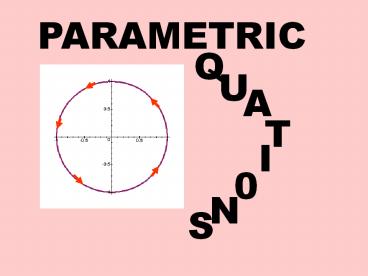PARAMETRIC - PowerPoint PPT Presentation
1 / 12
Title:
PARAMETRIC
Description:
PARAMETRIC Q U A T I 0 N S The variable t (the parameter) often represents time. We can picture this like a particle moving along and we know its x position over time ... – PowerPoint PPT presentation
Number of Views:102
Avg rating:3.0/5.0
Title: PARAMETRIC
1
PARAMETRIC
Q
U
A
T
I
0
N
S
2
The variable t (the parameter) often represents
time. We can picture this like a particle moving
along and we know its x position over time and
its y position over time and we figure out each
of these and plot them together to see the
movement of the particle.
3
Graph the plane curve represented by the
parametric equations
The t values we pick must be greater than or
equal to 0. Let's start with 0.
t
0
1
2
3
We'll make a chart and choose some t values and
find the corresponding x and y values.
We see the "path" of the particle. The
orientation is the direction it would be moving
over time (shown by the arrows)
4
We could take these parametric equations and find
an equivalent rectangular equation with
substitution. This is called "eliminating the
parameter."
Solve for the parameter t in one of equations
(whichever one is easier).
Substitute for t in the other equation.
2
2
We recognize this as a parabola opening up.
Since our domain for t started at 0, it is only
the right half.
5
Graph the plane curve represented by the
parametric equations
The t values we pick must be from 0 to 2 ?
t
0
Make the orientation arrows based where the curve
was as t increased.
You could fill in with more points to better see
the curve.
6
Let's eliminate the parameter. Based on our
curve we'd expect to get the equation of an
ellipse.
2
2
4
4
When you want to eliminate the parameter and you
have trig functions, it is not easy to solve for
t. Instead you solve for cos t and sin t and
substitute them in the Pythagorean Identity
Here is the rectangular version of our ellipse.
You can see it matches!
7
Your Casio graphic calculator can plot parametric
equations. Select Graph mode and check that
Type is set to Parm.
When you then enter a graph, it will have t for
the variable and you can enter more than one
equation.
If you watch as it draws the graph, you will see
the orientation (direction) of the curve.
8
If an object is dropped, thrown, launched etc. at
a certain angle and has gravity acting upon it,
the equations for its position at time t can be
written as
angle measured from horizontal
horizontal position
initial velocity
gravitational constant which is 9.8 m/s2
time
initial height
vertical position
9
Adam throws a tennis ball off a cliff, 300 metres
high with an initial speed of 40 metres per
second at an angle of 45 to the horizontal.
Find the parametric equations that describe the
position of the ball at time t.
How long is the ball in the air?
When the ball hits the ground, the vertical
position y will be 0.
use the quadratic formula
The negative time value doesn't make sense so we
throw it out.
10
Adam throws a tennis ball off a cliff, 300 metres
high with an initial speed of 40 metres per
second at an angle of 45 to the horizontal.
Find the parametric equations that describe the
position of the ball at time t.
When is the ball at its maximum height?
The motion is parabolic (opening down) so maximum
will be at the turning point.
What is the maximum height?
11
Adam throws a tennis ball off a cliff, 300 meters
high with an initial speed of 40 meters per
second at an angle of 45 to the horizontal.
Find the parametric equations that describe the
position of the ball at time t.
Determine the horizontal distance the ball
traveled.
Use time in air from first part of problem.
12
Acknowledgement I wish to thank Shawna Haider
from Salt Lake Community College, Utah USA for
her hard work in creating this PowerPoint. www.sl
cc.edu Shawna has kindly given permission for
this resource to be downloaded from
www.mathxtc.com and for it to be modified to suit
the Western Australian Mathematics Curriculum.
Stephen Corcoran Head of Mathematics St
Stephens School Carramar www.ststephens.wa.edu.
au































